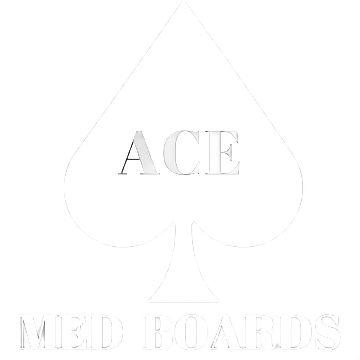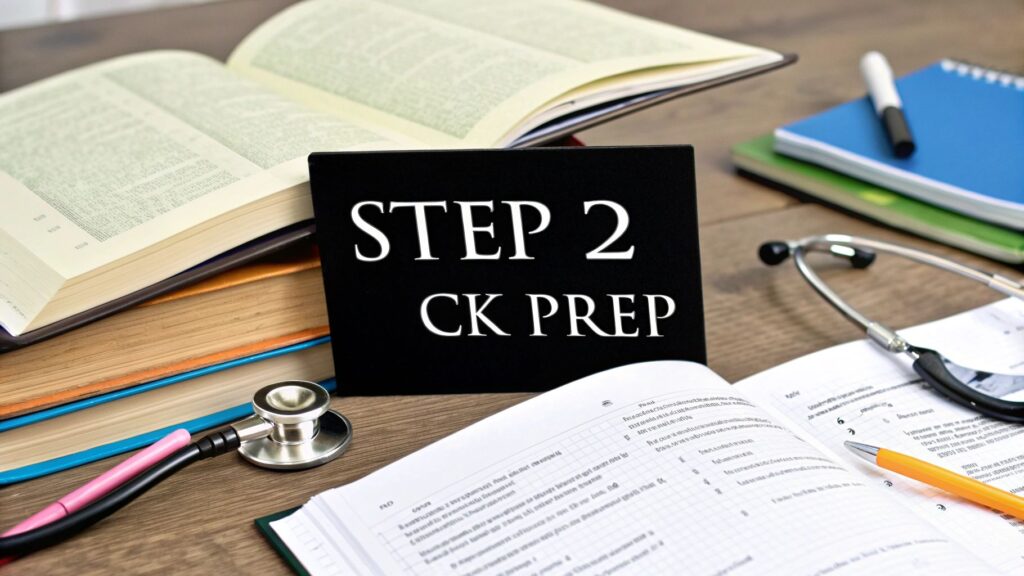The USMLE Step 2 CK exam stands as a pivotal milestone in your medical journey, a comprehensive test of clinical knowledge that directly impacts residency applications. With countless resources vying for your attention, choosing the right study materials is more than just a preference; it’s a strategic decision that shapes your preparation and final score. This guide cuts through the noise to provide a detailed, honest analysis of the top-tier books and digital resources for Step 2 CK.
We move beyond surface-level reviews to offer insights into practical usage, hidden limitations, and strategic integration. Understanding how to combine a question bank like UWorld with high-yield review texts is fundamental. To truly conquer the USMLE Step 2 CK exam, it’s crucial to understand its structure and content thoroughly, which allows you to select resources that directly address your weaknesses.
This roadmap is designed to help you assemble the optimal toolkit for your specific needs. Whether you're building a foundational knowledge base during your clerkships or fine-tuning your test-taking skills in the final, dedicated study period, this curated list will equip you with the best books for Step 2 CK and a clear plan to use them effectively.
1. UWorld Question Bank
While not a traditional textbook, the UWorld Question Bank (QBank) is unequivocally the single most essential resource for Step 2 CK preparation. It has earned its reputation as the gold standard by providing an extensive library of high-quality practice questions that meticulously simulate the format, style, and difficulty of the actual exam. Many students find it to be the most critical component among all the books and resources for Step 2 CK.
UWorld’s primary strength lies in its detailed explanations. For every question, it provides a comprehensive breakdown of why the correct answer is right and, just as importantly, why every other option is wrong. This approach moves beyond simple memorization, teaching the clinical reasoning and multi-step thinking required to excel on exam day.
Best Use Case and Strategy
UWorld is most effective when used as the central pillar of your dedicated study period. A common and highly successful strategy involves two passes through the QBank.
- First Pass (Tutor Mode): Begin your studies by doing blocks of questions in tutor mode. This allows you to review the detailed explanations immediately after answering each question, which is crucial for building a strong knowledge base. Focus on understanding the concepts, not just the answers.
- Second Pass (Timed Mode): After completing your first pass, reset the QBank and begin a second pass using timed, random blocks of 40 questions. This simulates the real exam environment, helping you improve your pacing and test-taking stamina. Many students reserve this pass for their final 4-6 weeks of study.
This following visual summarizes the key features that make UWorld an indispensable tool for Step 2 CK prep.
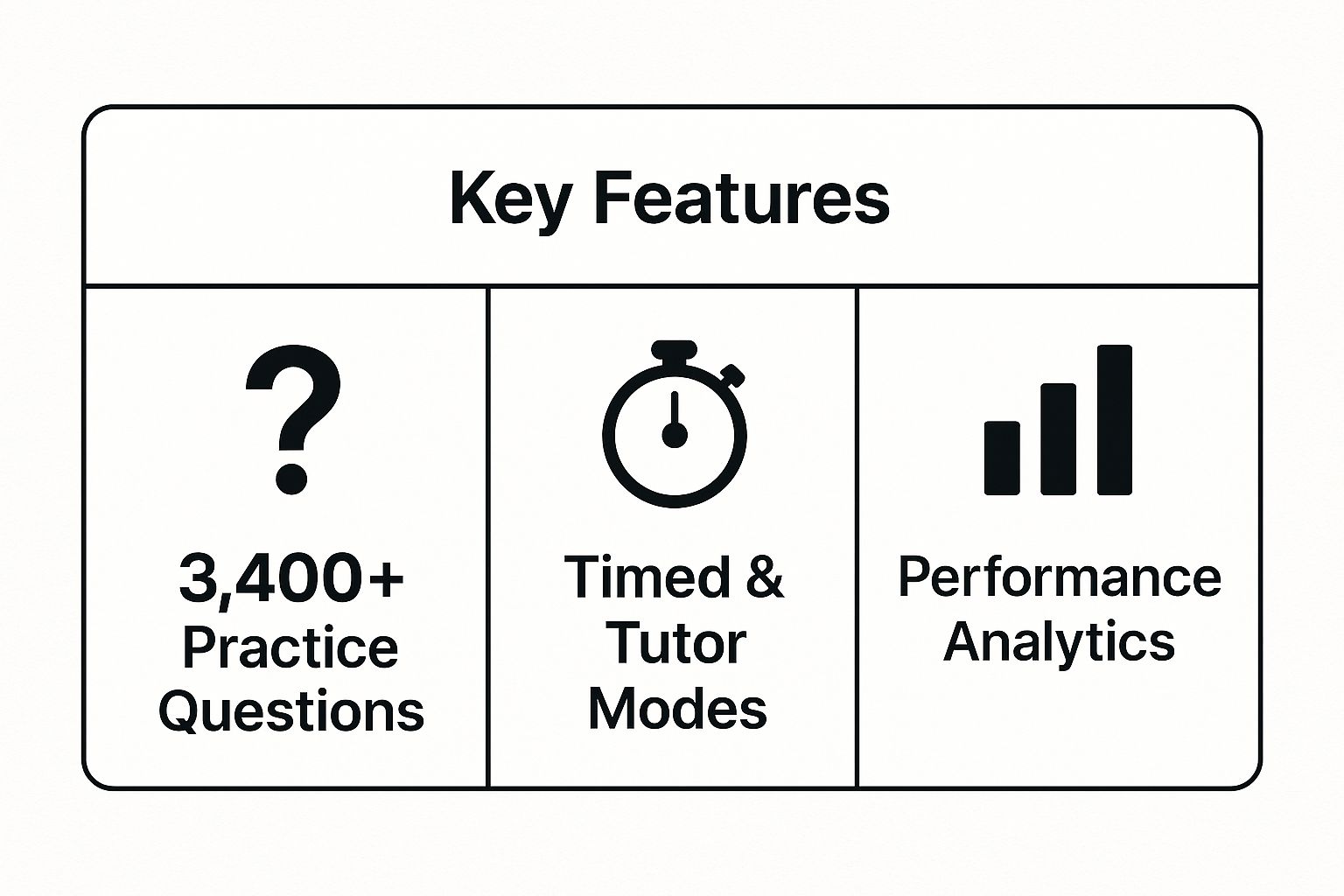
The combination of a massive question volume, flexible study modes, and detailed analytics allows you to identify and address your specific weaknesses effectively. For example, medical schools often integrate UWorld into their curriculum, a testament to its proven effectiveness in preparing students.
2. First Aid for the USMLE Step 2 CK
Often seen as the companion to its famous Step 1 predecessor, First Aid for the USMLE Step 2 CK serves as a high-yield review book rather than a primary learning text. It consolidates the essential clinical knowledge, diagnostic algorithms, and treatment protocols into a single, digestible volume. While not as universally central as the Step 1 version, it remains a valuable resource for reinforcing key concepts and is one of the most frequently referenced books for Step 2 CK preparation.
The book’s strength is its concise, fact-based presentation organized by medical specialty. It excels at providing quick-access information, clinical pearls, and "Next Step in Management" frameworks that are crucial for answering the exam's multi-step clinical vignette questions. Many students use it to fill knowledge gaps identified while working through question banks.
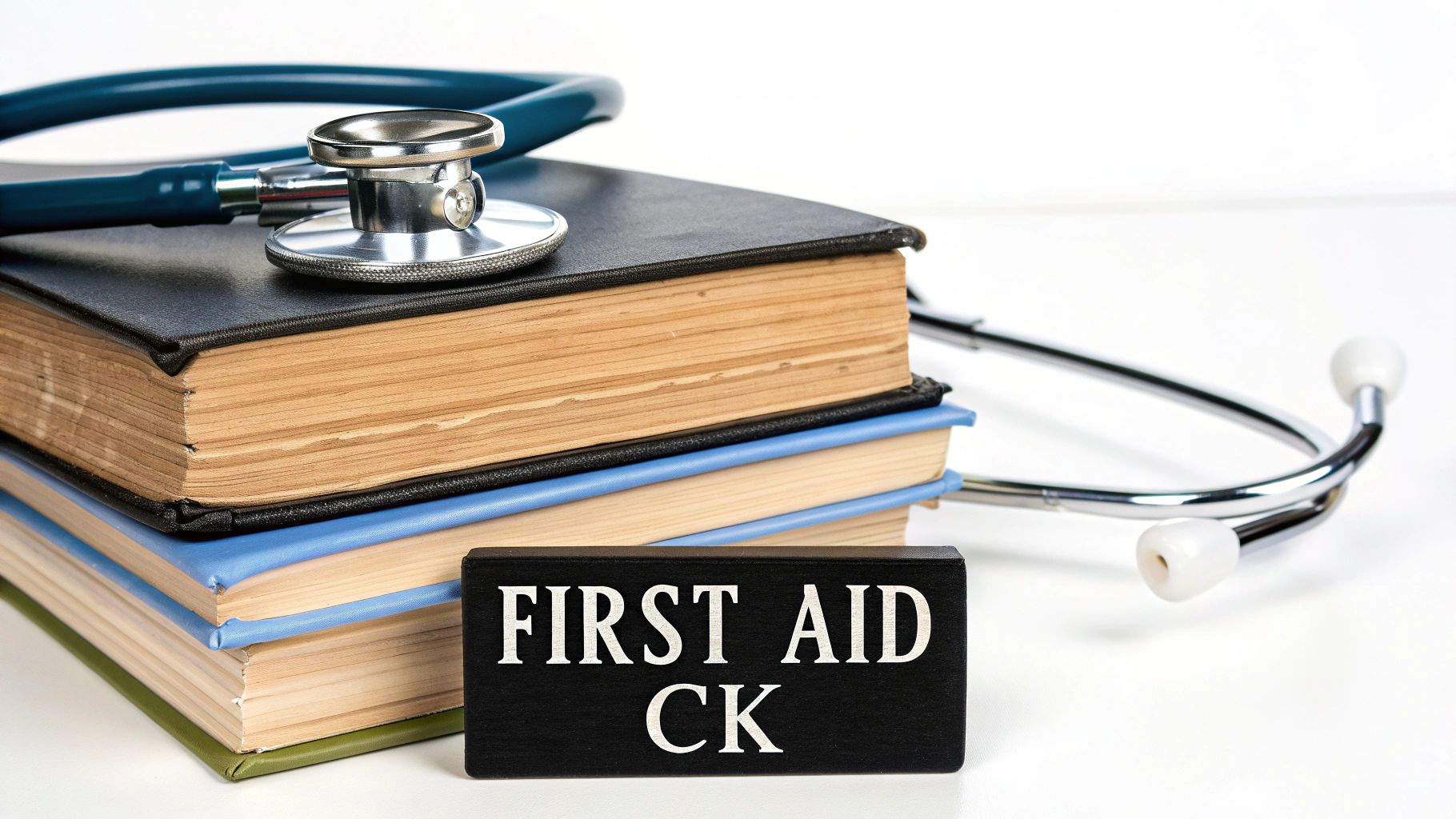
Best Use Case and Strategy
First Aid is best utilized as a supplementary reference and review tool, not as your core study material. Its primary function is to consolidate and organize information learned from more comprehensive resources like UWorld and clinical rotations.
- Targeted Review: Use the book to look up specific topics you struggle with in your QBank blocks. If you miss a question on acute pancreatitis, for instance, turn to the GI section in First Aid to review the diagnostic criteria, scoring systems, and management steps. This targeted approach is a key part of an effective strategy; for a deeper dive, you can explore more about how to study for Step 2 CK.
- Active Annotation: Many students annotate their copy of First Aid with notes and mnemonics from UWorld explanations. This transforms the book into a personalized, high-yield study guide that is incredibly useful for final review in the last weeks leading up to the exam.
- System-Based Skimming: During your dedicated study period, quickly skim the chapters corresponding to the medical specialty you are focusing on that day or week. This helps reinforce the most testable facts and provides a solid framework before you dive into practice questions.
By integrating it this way, First Aid becomes a powerful tool for reinforcing high-yield information and structuring your overall review, ensuring you have a firm grasp on the most frequently tested clinical concepts.
3. AMBOSS Question Bank and Knowledge Library
AMBOSS has rapidly emerged as a powerful and highly integrated resource, combining a robust question bank with an extensive, interconnected medical knowledge library. While UWorld remains the primary QBank for many, AMBOSS is considered by an increasing number of students to be an essential supplementary tool. It excels at bridging the gap between practice questions and in-depth content review, making it a valuable addition to any list of books for Step 2 CK.
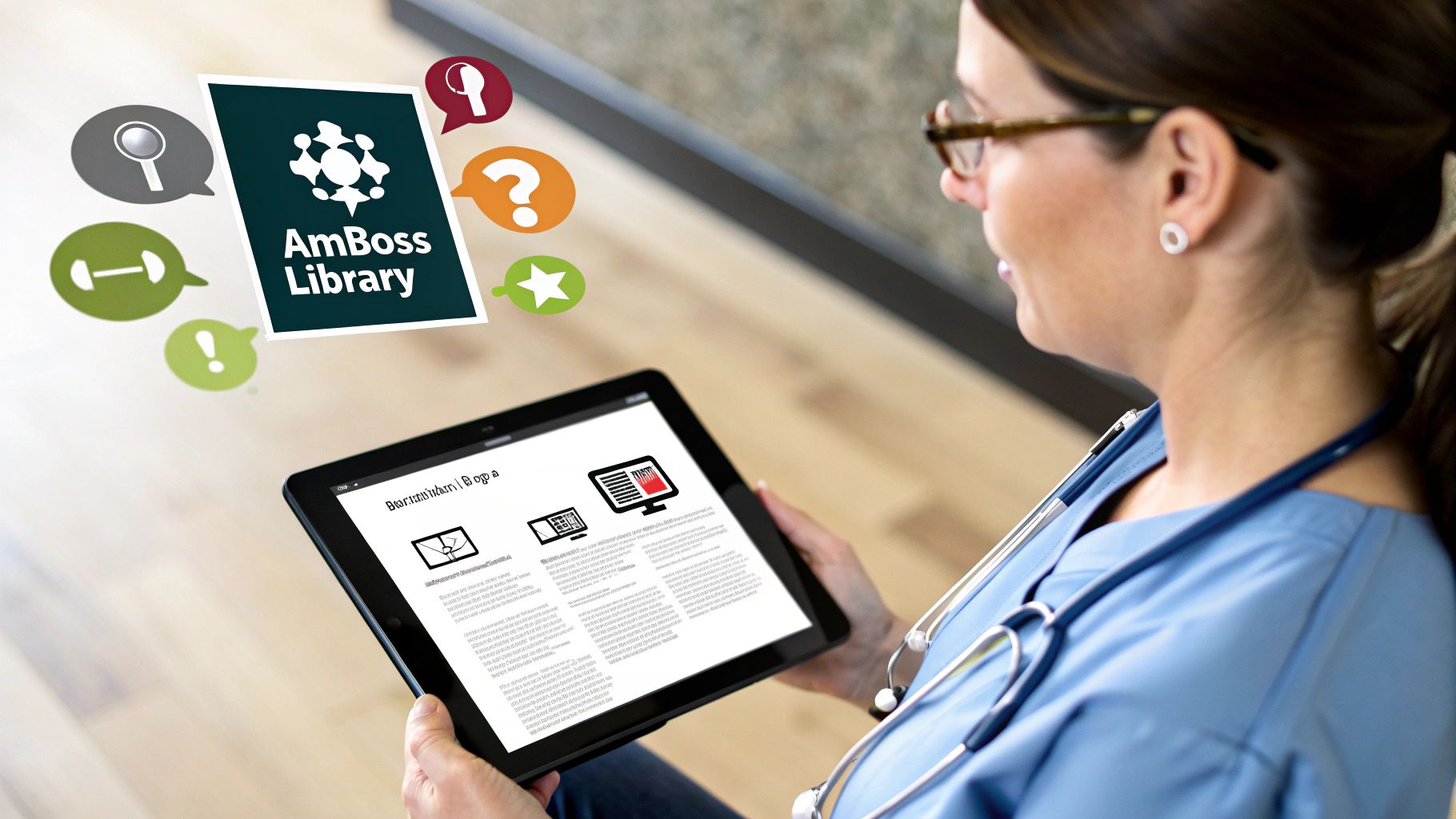
The platform's standout feature is its seamless integration. Answering a question in the AMBOSS QBank provides not only a detailed explanation but also direct links to relevant articles within its comprehensive knowledge library. This allows students to quickly pivot from a specific clinical scenario to a broader understanding of the underlying pathophysiology, diagnosis, and management principles without switching resources. The library itself is often used throughout medical school for clerkship and shelf exam preparation, a testament to its quality and depth.
Best Use Case and Strategy
AMBOSS is most effectively utilized as a secondary question bank and a primary reference library to supplement UWorld. Its questions, particularly those at higher difficulty levels, are known for testing nuanced concepts and pushing clinical reasoning skills.
- Targeted Content Review: Use the AMBOSS library to solidify weak areas identified through UWorld or self-assessments. If you consistently miss questions on nephrotic syndromes, for example, you can read the corresponding AMBOSS article, which provides a concise yet thorough overview.
- Secondary QBank Pass: After completing a first pass of UWorld, integrating blocks of AMBOSS questions can provide a fresh perspective and prevent question memorization. Focus on the platform's unique features, such as the "Attending Tip" and highlighting key information in the vignette, to refine your diagnostic approach.
- Clerkship and Shelf Prep: The AMBOSS library is an outstanding resource during your third-year clerkships. Using it consistently throughout the year will build a strong foundation, making your dedicated Step 2 CK study period more efficient.
The combination of a challenging QBank with a dynamically linked encyclopedia-like library makes AMBOSS a uniquely powerful learning system. It helps ensure that you not only know the answer but also deeply understand the "why" behind it.
4. Kaplan USMLE Step 2 CK Lecture Notes
The Kaplan USMLE Step 2 CK Lecture Notes is a comprehensive five-volume book set that offers an in-depth review of all subjects tested on the exam. For students who feel their foundational clinical knowledge has gaps or who prefer a structured, textbook-style approach to learning, this collection is among the most thorough books for Step 2 CK. It serves as a strong content-based backbone before diving into the application-heavy world of question banks.
Kaplan's strength is its detail. The set breaks down complex pathophysiology, diagnostic algorithms, and management guidelines into a digestible format. This makes it particularly valuable for students who need more than just the brief explanations found in QBank answers to truly grasp the underlying principles of a disease process. Many international medical graduates, for example, rely on Kaplan to build a robust knowledge base that aligns with US clinical standards.
Best Use Case and Strategy
Kaplan is most effective when used during the early phases of your Step 2 CK preparation to build a solid foundation. It is not meant to be a last-minute review tool.
- Foundation Building: Use the Kaplan notes in the initial months of your study period. Read through the subjects you feel weakest in to solidify your understanding before you start intense question-based learning. This prevents you from getting bogged down while doing UWorld questions on unfamiliar topics.
- Targeted Reinforcement: Instead of reading the books cover-to-cover, use them as a reference. When you consistently miss questions on a specific topic (e.g., glomerulonephritis) in your QBank, turn to the corresponding Kaplan chapter for a detailed review. This targeted approach is far more high-yield than passive reading.
The following video provides a student's perspective on integrating Kaplan's resources into a study plan.
Pairing the books with Kaplan's video lectures can enhance retention, as the visual and auditory reinforcement helps cement the dense material. However, always remember to supplement your reading with active learning, like creating flashcards for key facts or, most importantly, completing practice questions to ensure you can apply the knowledge.
5. Anki Flashcards (Zanki, AnKing, Cheesy Dorian)
Anki is a powerful, intelligent flashcard program that utilizes a spaced repetition system (SRS) to optimize memory retention. While not a traditional book, the user-created Anki decks, such as the comprehensive AnKing Overhaul, Zanki Step 2, and Cheesy Dorian, have become foundational tools for many top-scoring students. These decks contain thousands of pre-made flashcards derived from high-yield resources like UWorld and First Aid, covering clinical facts, diagnostic criteria, and management algorithms.
The core advantage of Anki is its algorithm, which schedules card reviews at increasing intervals based on your performance. This method efficiently moves information from your short-term to your long-term memory, ensuring you retain the vast amount of knowledge required for Step 2 CK. It combats the natural tendency to forget information, making it an indispensable partner to question banks and textbooks.
Best Use Case and Strategy
Anki is most effective as a daily habit for long-term knowledge consolidation, rather than a tool for last-minute cramming. Integrating it alongside your clinical rotations and UWorld studies is a highly effective strategy.
- Integrate with QBank Learning: After completing a UWorld block, "unsuspend" the corresponding Anki cards related to the topics you just reviewed. This reinforces the concepts you learned from the question explanations and helps solidify them.
- Daily Consistency is Key: The power of spaced repetition relies on daily reviews. Aim to complete all your due cards every single day. Limit the number of new cards to a manageable amount (e.g., 50-150 per day) to avoid becoming overwhelmed. Always prioritize completing your reviews over adding new cards.
- Personalize Your Deck: While pre-made decks are excellent, the true strength of Anki is realized when you create your own cards. Make cards for UWorld concepts you got wrong or found particularly challenging. Using the image occlusion add-on is especially useful for memorizing radiological images, EKGs, and dermatology findings.
The sustained, daily use of Anki is what sets it apart from simply rereading notes. Top Step 2 CK scorers frequently credit their success to the consistent reinforcement provided by Anki, and many medical schools now even incorporate Anki training into their curriculum. It is a vital tool among the different books and resources for Step 2 CK preparation.
6. UpToDate
While not a dedicated board review book, UpToDate is an indispensable clinical decision support tool that functions as an ultimate, real-time reference. It provides comprehensive, evidence-based summaries of virtually every medical topic. For Step 2 CK, its value lies in offering the most current, practice-oriented information, reflecting the "next best step" in management that the exam frequently tests.
UpToDate’s core strength is its depth and reliability. When a question bank explanation feels incomplete or a clinical scenario seems ambiguous, this resource provides the definitive answer based on current medical literature and expert consensus. Many residency programs provide institutional access, and its use is standard practice in clinical settings, making it an authentic source for understanding modern medicine.
Best Use Case and Strategy
UpToDate should be used as a targeted reference tool to supplement your primary study resources, not as a standalone study guide. It is perfect for clarifying complex topics or exploring the nuances of diagnosis and management that other books for Step 2 CK might oversimplify.
- Clarify Ambiguity: When you encounter a confusing concept in UWorld or another QBank, use UpToDate to search for the specific condition. Focus on the "Summary and Recommendations" section for a high-yield overview.
- Understand Algorithms: Pay close attention to the diagnostic and treatment algorithms. These visual flowcharts are excellent for solidifying the step-by-step clinical reasoning required for the exam.
- Avoid Rabbit Holes: The sheer volume of information can be overwhelming. Discipline yourself to find the specific information you need and then return to your structured study materials. Do not attempt to read entire topics from start to finish. For more strategies on integrating reference tools into your study schedule, you can find further medical school exam preparation tips.
By using it strategically to fill knowledge gaps identified by your core resources, UpToDate becomes a powerful tool for achieving a deeper, more clinically relevant understanding of the material tested on Step 2 CK.
7. NBME Clinical Mastery Series and Practice Exams
The NBME (National Board of Medical Examiners) practice materials are the closest you can get to the real Step 2 CK exam. Because they are created by the very organization that writes and administers the actual test, their questions, format, and style offer the most authentic simulation available. These resources are indispensable for gauging your readiness and identifying your standing before test day.
The primary value of NBME exams lies in their predictive power. The score you receive on a late-stage NBME practice test is often a highly accurate predictor of your potential performance on the actual Step 2 CK. This makes them a critical assessment tool, distinct from the learning-focused design of resources like UWorld. Many medical schools even require students to pass an NBME exam before authorizing them to sit for the official test.
Best Use Case and Strategy
NBME practice exams are best used as progress benchmarks and final predictors, particularly in the later stages of your dedicated study period. They are not primary learning tools due to their lack of detailed explanations, but they are unmatched for assessment.
- Clinical Mastery Series (CMS): These are shorter, subject-specific forms (e.g., Medicine, Surgery, Pediatrics). Use these throughout your study period to target and assess weak areas. If you're struggling with a particular subject, a CMS form can provide an accurate snapshot of your knowledge gaps.
- Full-Length Practice Exams: Save the full-length Comprehensive Clinical Science Self-Assessments (CCSSAs) for the last 3-4 weeks before your exam. Space them out, taking one every week or two to track your progress and simulate the grueling experience of a full test day. Use your scores to make final adjustments to your study plan.
The strategic use of these official materials is a cornerstone of a well-rounded preparation plan. To better understand how to integrate these exams into your schedule, you can learn more about how to use the NBME practice exams for Step 2. These assessments are less about learning new information and more about understanding the test-setter's mindset, making them a vital part of any list of books and resources for Step 2 CK.
Top 7 Step 2 CK Resources Comparison
| Resource | Core Features / Highlights | User Experience / Quality ★ | Value Proposition 💰 | Target Audience 👥 | Unique Selling Points ✨ | Price Range 💰 |
|---|---|---|---|---|---|---|
| UWorld Question Bank | 3,400+ practice Qs, detailed explanations, analytics | ★★★★☆ High correlation with real exam | Premium quality but expensive | Med students prepping USMLE Step 2 CK | Timed & tutor modes, frequent content updates 🏆 | High ($$$) |
| First Aid for USMLE Step 2 CK | Specialty-organized, high-yield facts, mnemonics | ★★★★☆ Trusted quick-review book | Great supplement for review | Students needing concise clinical facts | Annual updates, clinical images ✨ | Moderate ($$) |
| AMBOSS Q Bank & Knowledge Library | 2,500+ Qs, 8,000+ articles, spaced repetition | ★★★★☆ Integrated Q bank + knowledge library | Good combined Q&A + facts value | Med students & residents | Difficulty indicators, clinical reasoning focus ✨ | Moderate ($$) |
| Kaplan USMLE Step 2 CK Notes | 5-volume set, detailed clinical topics, case examples | ★★★★☆ Comprehensive foundation content | Expensive but thorough | Students needing in-depth content review | Clinical correlations, illustrations ✨ | High ($$$) |
| Anki Flashcards (Zanki, AnKing) | Thousands of spaced repetition cards, customizable | ★★★★☆ Excellent for memorization and retention | Free and customizable | Self-motivated learners, lifelong use | Image occlusion, community decks ✨ | Free |
| UpToDate | Evidence-based clinical info, calculators, CME | ★★★★★ Trusted clinical resource, very detailed | Very expensive, professional use | Clinicians, advanced learners | Real-time updates, drug info, decision tools ✨ | Very High ($$$$) |
| NBME Clinical Mastery & Practice | Official practice exams, authentic format | ★★★★★ Most authentic exam simulation | Pricier but crucial for readiness | Step 2 CK candidates needing exam simulation | Officially developed by exam board 🏆 | High ($$$) |
Crafting Your Winning Strategy: From Resources to Results
Navigating the landscape of resources for the USMLE Step 2 CK can feel like its own high-stakes exam. We’ve explored the titans of test prep, from the indispensable UWorld question bank to the encyclopedic AMBOSS library and the rapid-review format of First Aid for the USMLE Step 2 CK. The ultimate takeaway is not that one single resource holds the key, but that a well-orchestrated combination, tailored to your unique learning style, is what builds a top-tier score.
Your journey should be a dynamic process of active learning, not passive consumption. The most successful students don't just read these books; they engage with them, question them, and integrate them into a cohesive system. This means moving beyond simply completing UWorld blocks and truly analyzing every explanation, both for correct and incorrect answers. It means using Anki not as a chore, but as a non-negotiable daily tool to cement the high-yield facts you’ve just learned.
Building Your Personalized Study Arsenal
The core of any competitive Step 2 CK preparation plan will almost universally feature UWorld and a robust Anki deck like AnKing. This duo forms a powerful engine for active recall and spaced repetition, the cornerstones of long-term retention. Think of it this way: UWorld is where you build your clinical reasoning and diagnostic muscles, while Anki ensures that foundational knowledge remains sharp and instantly accessible.
From there, you can customize your approach:
- For foundational gaps: Use Kaplan’s Lecture Notes early on to build a solid base before diving deep into questions.
- For quick, high-yield review: Keep First Aid for Step 2 CK on hand to consolidate concepts or for last-minute cramming sessions.
- For challenging topics: When a UWorld explanation isn't enough, turn to the AMBOSS Knowledge Library or UpToDate for a deeper, more comprehensive understanding of complex pathophysiology or management guidelines.
- For performance benchmarking: Strategically schedule NBME practice exams throughout your dedicated study period. These are your most accurate predictors of performance, highlighting your weaknesses with clinical precision so you can adjust your focus accordingly.
Ultimately, choosing the right books for Step 2 CK is just the beginning. True mastery comes from the strategic synthesis of these tools. Beyond specific study materials, success in demanding exams like Step 2 CK also hinges on effective test-taking strategies and mental well-being. For additional insights on managing exam-related stress, explore these tips against exam anxiety for medical students. Remember, your goal is to build a web of knowledge, not a list of memorized facts. By actively integrating these resources, you transform your preparation from a checklist of tasks into a powerful, score-boosting strategy.
Feeling overwhelmed by the options or unsure how to build your personalized study schedule? The expert tutors at Ace Med Boards specialize in helping medical students create and execute high-yield study plans using these exact resources to maximize their Step 2 CK scores. Visit Ace Med Boards to learn more and schedule a free consultation.
